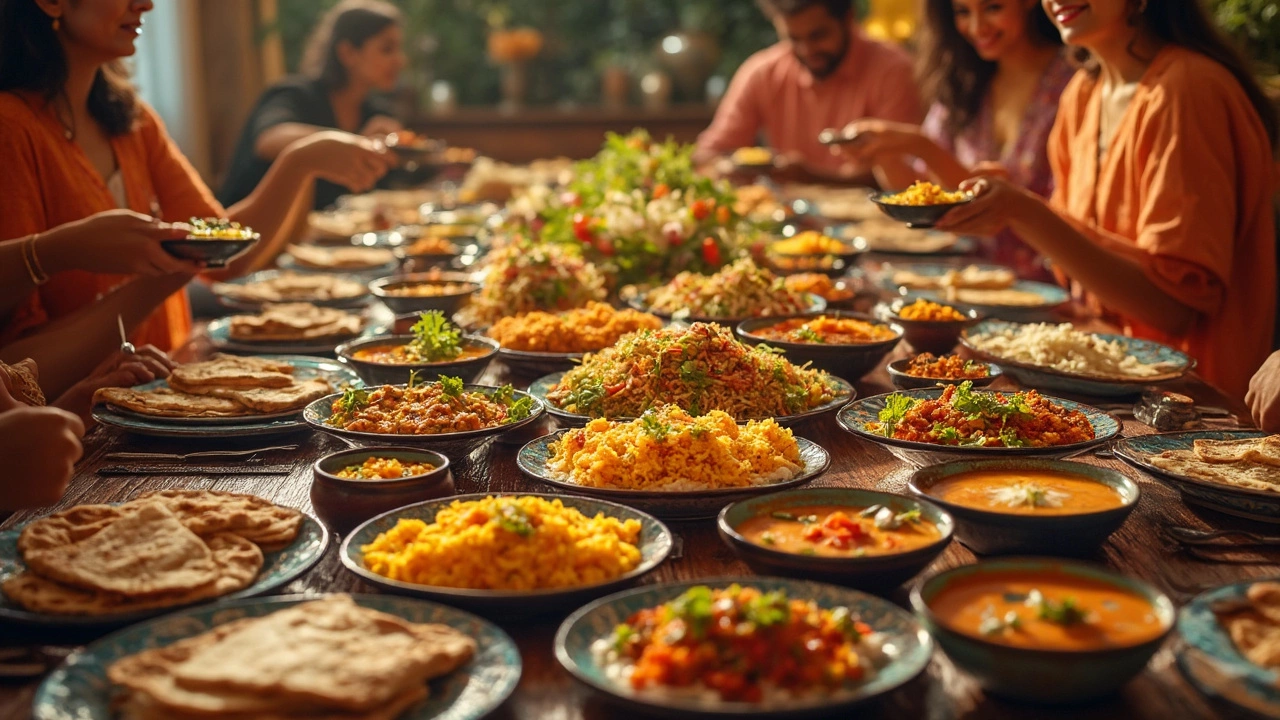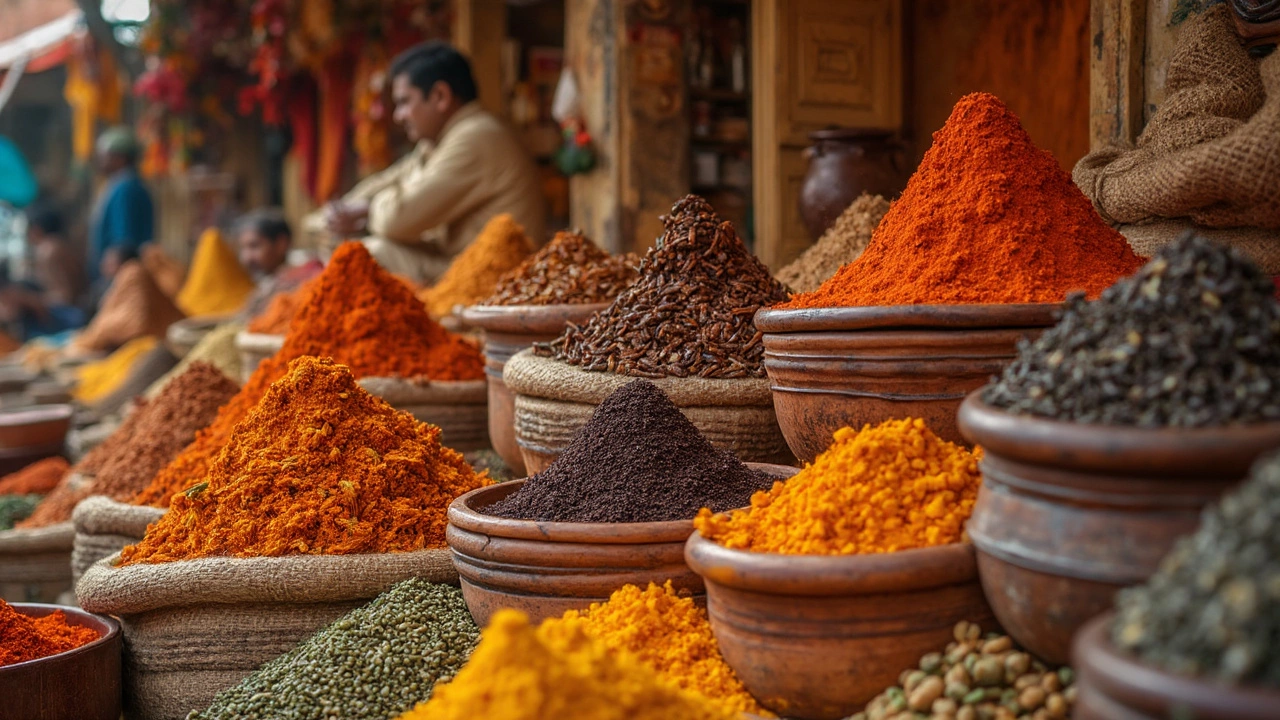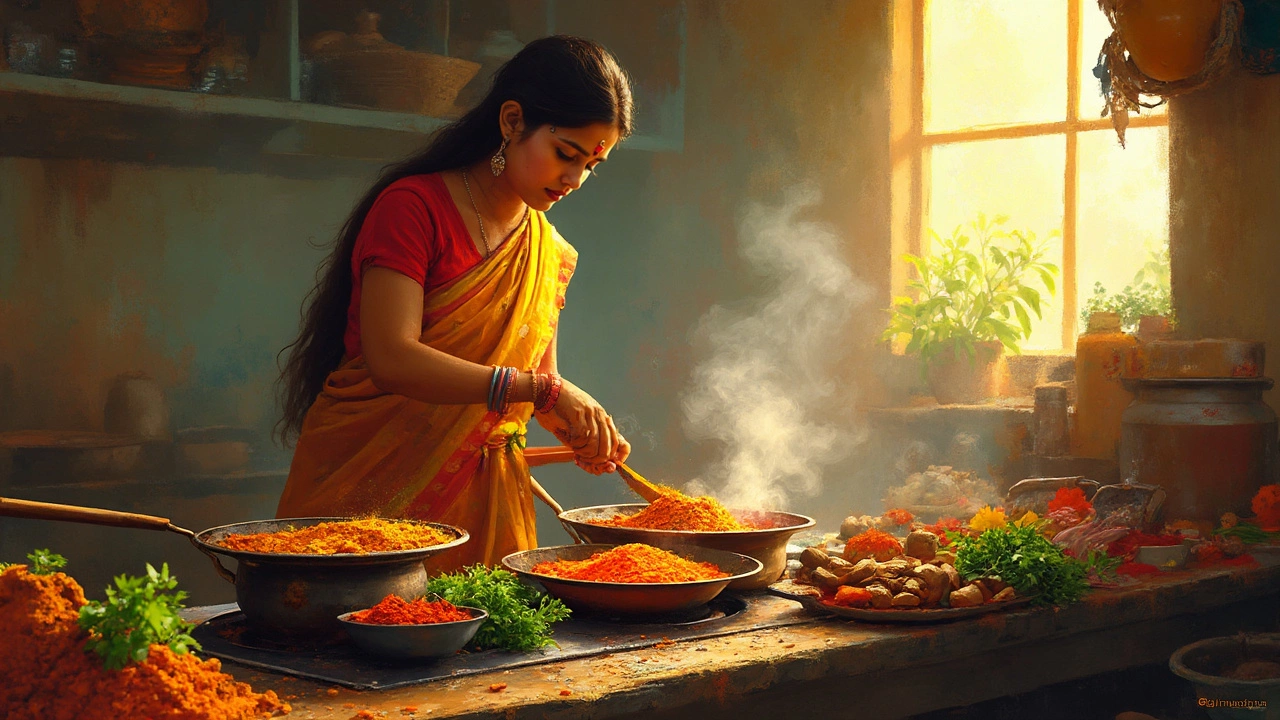Indian cuisine is like a colorful painting—there’s something for everyone. If you’ve ever wondered what the most common Indian meal is, you’re not alone. No, it’s not always the familiar chicken tikka masala. In homes across India, the humble dal with rice or roti steals the spotlight. Simple, comforting, and versatile, it’s a mealtime staple for millions.
Dal, which is essentially lentil curry, can be whipped up with just a few ingredients. It's flavorful, nutritious, and easy on the pocket. Paired with rice or roti (Indian flatbread), it’s the ultimate comfort food. Plus, the leftovers taste even better the next day. Talk about a win-win!
But it’s not just about dal. Indian kitchens are bustling with various easy recipes that make daily dining delightful. From fluffy rotis to tangy pickles, each corner of India has its own version of ‘everyday food,’ reflecting regional flavors and ingredients.
- Understanding Indian Cuisine Basics
- What is the Most Common Indian Meal?
- Easy Indian Recipes for Your Kitchen
- Spices and Ingredients You Need
- Cooking Tips and Tricks
Understanding Indian Cuisine Basics
Indian cuisine isn't just about spicy food that sets your mouth on fire. It's a vast tapestry of flavors, traditions, and regional specialties. And while it seems complicated from the outside, the basics are surprisingly approachable.
Let's start with the fundamentals. Indian meals often revolve around staple foods like rice, roti (flatbread), and dal (lentils). These form the backbone of many meals and provide the hearty satisfaction people seek in their everyday cooking.
"A good Indian curry is all about the harmonious blend of spices," says Manish Mehta, a famous Indian chef. "It’s the spices that make the dish come alive."
This brings us to the aromatic world of spices. Essential in any Indian kitchen are turmeric, cumin, coriander, and garam masala. These aren't just for flavor but also for their health benefits, like turmeric's anti-inflammatory properties.
- Tamarind for tanginess.
- Fenugreek to add a bit of bitterness.
- Mustard seeds for an earthy kick.
It’s no wonder then, why so many people adore Indian food—the possibilities are practically endless!
And it’s not just about ingredients. Cooking techniques like tempering—a process where spices are briefly roasted in oil to release their flavors—can turn your dish from meh to wow with just a small effort. You'll find versatility is key, as many Indian recipes are adaptable based on what's available in your pantry.
If you're looking to incorporate Indian cooking into your routine, start simple and keep experimenting. Trust me, your taste buds will thank you!
What is the Most Common Indian Meal?
When you think of an everyday Indian meal, what pops into your mind? It's probably something aromatic with a hint of spice, right? While India's culinary scene is as diverse as its culture, one meal stands out in many households: dal with rice or roti.
Dal, a term for lentils, is an absolute staple. It comes in many types—like masoor (red lentils), toor (pigeon pea), and moong (green gram)—each bringing its own flavor to the pot. Cooked down into a thick soup or thin broth, dal is seasoned with spices like cumin, turmeric, and sometimes chilies.
| Lentil Type | Time to Cook | Protein Content (per 100g dry) |
|---|---|---|
| Masoor Dal | 20 minutes | 25g |
| Toor Dal | 30 minutes | 22g |
| Moong Dal | 15 minutes | 24g |
Pair this comforting dish with rice or roti, and you’ve got a meal that’s simple yet satisfying. Roti, a round flatbread, is made from whole wheat flour and cooked on a flat pan. It’s soft, slightly chewy, and perfect for scooping up dal.
Why is this meal so common? Apart from being nutritious—trust me, lentils are full of protein and fiber—it’s budget-friendly and can easily be adapted to suit personal tastes. You can make it as spicy or mild as you like, add veggies, or even toss in some fresh herbs for a change.
Whether you're crunched for time or just want something comforting, this easy Indian recipe is ideal. It’s like the PB&J of Indian kitchens—quick to make and loved by almost everyone.

Easy Indian Recipes for Your Kitchen
If you're just getting into Indian cooking, starting with the basics is the way to go. You don't need a pantry full of exotic ingredients or hours of preparation time. In fact, some of the best Indian meals are incredibly simple to make right at home.
Let’s kick things off with a cozy bowl of dal. Grab some lentils—red lentils (masoor dal) are a good bet because they cook fast. Rinse them a few times and start boiling with water. A quick tip: Add a pinch of turmeric and salt for flavor and color. While that's bubbling away, you'll want to temper it with some spices.
Take a tablespoon of ghee or oil, heat it in a small pan, and toss in mustard seeds, cumin seeds, and a pinch of asafoetida. This smoky-sweet mix adds a fabulous pop of flavor. Pour it over your dal, give it a stir, and—voila!—you’ve just made a staple Indian meal.
"A well-made dal with rice is the epitome of comfort food," says Chef Sanjeev Kapoor, a celebrated name in Indian cuisine. "It's nutritious, adaptable, and can fit any budget."
Next up, let’s talk about rotis. Made from whole wheat flour, these simple flatbreads are the partner-in-crime to many an Indian dish. Mix the flour with a little water and knead it into a dough. Allow it to rest for about 30 minutes. Roll flat and cook on a hot skillet until golden spots appear. It’s easier than you think and so rewarding when they puff up!
- Indian meal essentials: Dal, rice, or rotis
- Spice it up: Turmeric, cumin, mustard seeds
- Don’t forget: A good dal or roti is all about balancing flavors
Now, for those who love a bit of tang and zest, a quick mango or lime pickle can really elevate things. Just chop, marinate with salt, mustard oil, and let it sit for a day if you've got the patience. Trust me, it's a game-changer!
And let's not overlook the importance of a simple curry. Chickpea curry, also known as chana masala, is another easy Indian recipe to try. Just sauté onions, tomatoes, and ginger-garlic paste, add in chickpeas and spices like garam masala, and you're set with a wholesome meal.
For those curious about time commitments, here's a quick guide:
| Dish | Preparation Time | Cooking Time |
|---|---|---|
| Dal with Rice | 5 minutes | 15 minutes |
| Rotis | 10 minutes | 5 minutes |
| Chana Masala | 10 minutes | 20 minutes |
Incorporating these common Indian dishes into your weekly menu doesn't have to be a daunting task. With just a bit of effort, you can enjoy a delicious, wholesome meal that brings a slice of India into your home.
Spices and Ingredients You Need
To nail that authentic Indian meal, having a well-stocked spice rack is like having a magic wand in your kitchen. Trust me, the right spices can take your dish from bland to bang-on!
First up, let’s talk about the must-have spices. You’ll want turmeric for its earthy flavor and vibrant color. It’s sort of like a mood brightener for your food. Then there’s cumin, which has a warm, nutty aroma. Ground or whole, it’s an absolute staple in Indian cooking.
- Coriander: Offers a fresh, citrusy touch and works wonders in both savory dishes and pickles.
- Garam Masala: A blend of several spices, like cloves, cinnamon, and cardamoms. Give your dishes that intense flavor kick with this one.
- Chili Powder: Indians love a bit of heat, and a sprinkle of this can awaken your taste buds.
- Cumin: Perfect for adding earthy notes; use it in dal, curry, or even sprinkle it on your salad.
When it comes to ingredients beyond spices, lentils are your best friends. Easily available and versatile, they are the heart of many common Indian dishes. Don’t forget rice and flour, the bases for rice and rotis.
Of course, fresh herbs like coriander and mint should always be at arm's reach. They add freshness and lift the whole dish. And, if you're feeling adventurous, try using ghee (clarified butter) for an authentic taste—there's something special about that buttery aroma wafting through your kitchen.
Let’s not overlook the power of ginger and garlic—often turned into a paste—that you’ll find in practically every dish. They form the flavorful backbone of easy Indian recipes.
With these basics in your pantry, you’re all set to create some extraordinary meals. Whether you’re crafting a humble dal or an extravagant biryani, having these ingredients on hand is half the battle won.

Cooking Tips and Tricks
Cooking Indian meals can seem daunting at first, but it’s actually a lot easier when you know a few handy tricks. First off, always keep your essential spices organized and within reach. Spices like cumin, turmeric, and mustard seeds form the backbone of many Indian recipes.
One of my personal favorites for making dal is using a pressure cooker. It cuts down cooking time significantly and ensures the lentils are cooked just right every time. If you're reluctant about using one, an Instant Pot works magic too!
When cooking rice, add a few drops of lemon juice to the water. This keeps the grains from sticking together and lends a lovely, subtle fragrance. For those perfect rotis, let your dough rest for at least 15 minutes after kneading.
- Fresh ingredients make for great flavor, so if you can, grind your own spice blends in small batches.
- When it comes to onions, cook them slowly until they're golden-brown; this caramelization brings out a sweet depth that adds richness to your curries.
- Don't shy away from garnishing your dishes with freshly chopped coriander; it adds brightness and a fresh zing.
And if you're ever short on time, remember that frozen peas can be your savior. They're quick to cook and can add a pop of color and nutrition to many dishes.
Finally, while getting the hang of cooking common Indian dishes, it’s crucial to taste as you go. Adjust spices and flavors according to your preference. After all, cooking is as much about following recipes as it is about making them your own!
